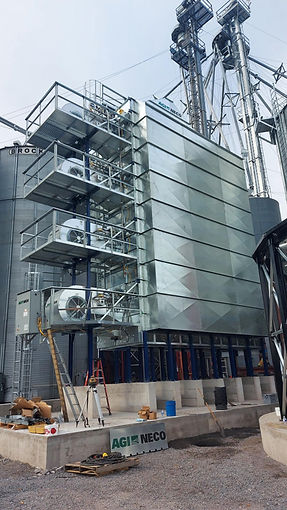GRAIN
DRYING

Primary Objective
The primary objective of a grain dryer is to lower the moisture content of the grains to a level that is suitable for storage. When grains are harvested, they typically have a high moisture content, which makes them vulnerable to spoilage. If not properly dried, the grains can undergo fermentation, sprouting, and microbial growth, resulting in reduced quality and economic losses for farmers. By utilizing a grain dryer, farmers can rapidly remove excess moisture from the grains, reducing the risk of spoilage and enabling long-term storage.
Drying Method
Grain dryers utilize various drying methods to achieve the desired moisture reduction. The most common type of grain dryer is a high-temperature dryer, which uses hot air to evaporate the moisture from the grains. These dryers consist of a drying chamber, a heat source (such as propane or natural gas burners), and a system for circulating the heated air through the grains. As the hot air passes through the grains, it absorbs the moisture, which is then expelled from the dryer through ventilation systems.
Benefits of Using a Grain Dryer
The benefits of using a grain dryer are manifold. Firstly, it ensures that the grains meet the required moisture standards for safe storage. Different grains have specific moisture content thresholds that must be met to prevent spoilage. By utilizing a grain dryer, farmers can precisely control the drying process and achieve the desired moisture levels, preserving the quality of the grains and preventing losses due to spoilage.
Secondly, grain dryers help reduce the harvesting window. Harvesting crops at high moisture levels can be risky, as it increases the likelihood of adverse weather conditions, pests, and diseases affecting the crops. By using a grain dryer, farmers can quickly reduce the moisture content of the harvested grains, allowing for a more flexible and efficient harvesting schedule.
Moreover, grain dryers enable farmers to take advantage of favorable market conditions. By drying their grains, farmers can store them for longer periods, allowing them to wait for optimal market prices. This flexibility can result in better financial returns and improved profitability.
Conclusion
In summary, the purpose of a grain dryer is to remove excess moisture from harvested grains, ensuring their safe storage and preserving their quality. By controlling the moisture content, grain dryers prevent spoilage, reduce losses, and enable farmers to take advantage of favorable market conditions. Whether through high-temperature or low-temperature drying methods, grain dryers are essential tools for modern agricultural practices, providing farmers with greater control over their harvests and promoting long-term sustainability in the grain industry.
